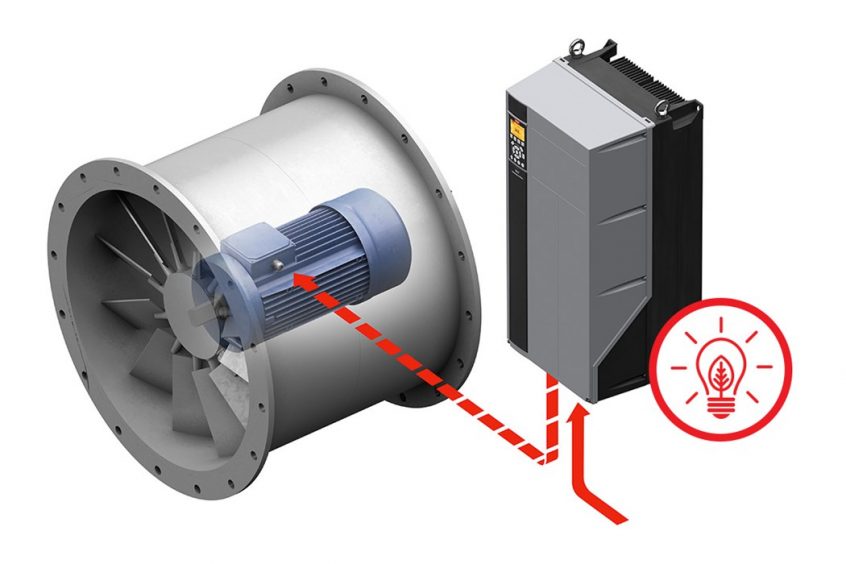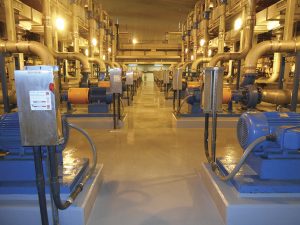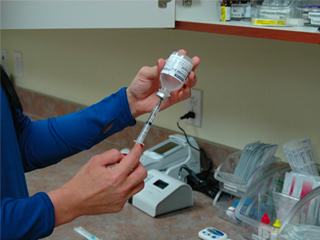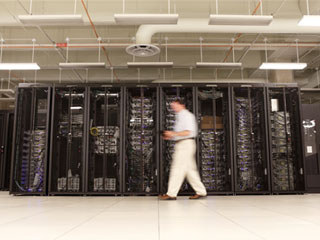Data centers consume significant amounts of energy, not only to operate IT equipment but to keep the IT equipment cool. In many data centers 40% is used to cool the IT system. Enabling such energy consumption makes sure that data centers are running 24/7. That would be a PUE of 1.4. Some data centers can have a PUE as high as 2.0
There has been a movement to address the increasing energy consumption for data centers. The focus is now on improving the power usage effectiveness (PUE) of data centers. Relative considerations are also put forth in choosing more efficient fans, pump, or HVAC system. Beyond the objective to maximize data center uptime, the efficient use of energy is also increasingly important.
Better Energy Consumption Using VFD
An effective solution for improving energy consumption is the implemention of VFD. Variable Frequency Drives (VFD) serve as controllers that enable the control of an induction motors’ speed. Simply put, a VFD can control the rotation speed of fans, pumps and compressors. Through which energy consumption is limited to what is needed by the equipment.
How Does a VFD Increase Energy Savings?

Photo Credit: www.gozuk.com
The frequency and voltage of the power supply are directly proportional to the speed and torque of an AC induction motor. In this regard, the power supply is constant if frequency and voltage are fixed. Despite changes in the speed and torque of engines that power the rotational capacity of a fan, electricity will remain the same.
This is where VFD becomes handy. They work to intercept the incoming power supply. Given an interception, VFD will then modify the voltage and AC frequency depending on the load requirements. The result, in turn, will adjust the speed and torque of the motor to match the loan demand without compromising precise output. Consequently, if the demand changes, the speed of the fans will keep pace.
In terms of energy savings, optimum run at a shorter period can significantly lower energy outputs. VFD can function to control the machines to run at higher-rated speeds for a particular period. This move is on a case-to-case basis and should be done cautiously.
When VFD is not in play, fixed AC motor speed and torque will likely be wasted in the process. This is because the limited speed and torque operations will be operated in a constant regardless if it is needed or not.
Such situations are highly probable to HVAC fans. When air supply-demand goes low, the air blown will remain constant. This will fill the entire space and would technically change the temperature parameters. If too much cold air is supplied, it goes beyond the standard parameter conditions. Such a case will be worse than good. The space will then try to dissipate cold air through the vents and valves. A lot of the air supply will be diverted to waste in the end.
In cooling systems, some fans are also integrated to cover the maximum cooling demand. However, an ultimate cooling condition is not necessarily the norm every operation day. Cooling parameters will likely be below the maximum cooling limit. In this context, energy again is wasted. The cooling system is operating at higher default, thereby pouring out the highest energy output. Unfortunately, there is an air supply surplus, and efficiency is not attained.
Other Benefit of a VFD in a Data Center
More than lesser energy consumption, integrating VFD to a data center will fare well in a data center operation. The speed control capacity will affect other operational capabilities as well.
- VFD Give More Accurate Process Control
When it comes to accurate process control, variable speed drivers are the best option. Variable speed drives enabled by VFD are a go-to AC motor control method with better load specifications than others.
In comparison, full voltage starters will power any motor with full speed. On the other hand, soft starters will gradually force full speed and then revert to shutoff. Such a mechanism will be more detrimental in a cooling system. It also elicits more energy exertion from the get-go and when shutting down.
Variable frequency drives will adjust motor run at pre-programmed speed and at a particular time interval. A variable drive running in an open-loop operation will gauge output to the programmed input value. The measurement will regulate speed depending on current load demand. The adjustment will be automatic for output to revert at the estimated set point.
- Use of a VFD Can Increase Machine Life
Forceful start subjects the motor to an enormous amount of torque pressure. The power needed for the start-up surge will be beyond the full-load current. This start dynamics will induce more mechanical stress to the motor. An electrical surge can also cause further voltaic issues.
To a certain extent, reduced-voltage soft starters function to start up a motor gradually. However, the programmability of drives to operate at certain preconditions negates stress better. Providing gradual and smooth starts can reduce wear and tear in the process. VFD is also significant in running specialized motor patterns. When applied to a conveyor, VFD will enable smoother acceleration and deceleration motion. Such capacity lowers the backlash to the conveyor during operation.
- Reducing Maintenance And Problems

Photo Credit: www.csemag.com
The adverse effect of a full-load current is a significant source of issues in a cooling system. Instantaneous energy will cause voltage sag on the power system. The heavy current drop after a full-speed will affect other loads negatively as well. It is referred to as shock damage and will elicit enormous wear and tear to the motor.
Total load capacity is a recurring problem in maintaining sustainable cooling systems. Much more in the case of a data center, cooling systems are reduced to excessive motor function to attain optimum conditions. But again, a full air supply is not directly proportional to sustainable temperature conditions. It only highlights that enabling cooling motors at total capacity does not recognize the optimum temperature setpoint. What is left is air supply waste that will be streamed to the vents to adjust the temperature condition.
Instant energization is a starting method that will pose problems in the long run. It will push technicians to consider motor sizes because full-voltage starters will cause problems across the line. This will be further problematic if the full-load start affects the whole utility system. It can potentially result in downtimes and create issues for the end-users.
It is instead a bigger problem in the context of maintenance. Not only will it extract significant capacities in repairs and maintenance. It will also bring forth additional operational checkpoints. Instead of streamlining a data center operation, much focus is given to repairing a fan motor.
Other Considerations For Data Center Energy Consumption
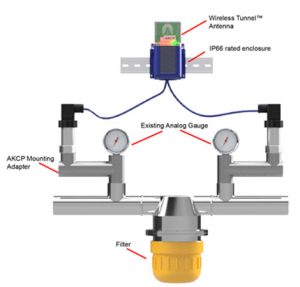
The power usage effectiveness is part of a regulatory parameter of data centers to control its energy usage. As such, data centers are also inclined to lower their PUE. At the forefront of this initiative is using VFD to realize energy-efficient motors.
However, there are other considerations to make sure energy output is low. Initial planning of data centers integrates proper design layout for the IT hardware and fan design. It is essential to consider all components to gauge the efficiency of a cooling system.
Other than that, efforts to integrate monitoring capacities are also a key consideration. As data centers develop into higher density facilities, heat loads are no longer dependent on the cooling system alone. Proper supplemental mechanisms such as monitoring technologies are paramount.
AKCP HVAC Maintenance Monitoring provides a comprehensive solution to air handling unit monitoring. Sound control of temperature, humidity, filtration, and building pressure is crucial as air handling units impact a data center’s energy use.
AKCP air handling unit monitoring system can diagnose faults such as:
- Compressor short cycling
- Compressor overheating
- Over or under pressure
- Dirty air filters
Furthermore, AKCP air handling unit monitoring accounts system control as well. For example, using VFD to control motor speed to better match the hydraulic energy of the chiller to that of the demand load, electrical energy consumption is reduced. As a valuable monitoring capacity enables AKCP to interface with VFD through RS485. The functionality to connect with VFD enables better speed control based on the data input from AKCP wireless sensor.
These monitoring capacities will bring forth:
- Better diagnosis of common faults by technicians remotely
- Lower overhead but increased efficiency on the cooling system
- Improved monitoring of air handling units
- Enhanced monitoring of chilled water cooling system
VFD For Better Cooling Efficiency
There’s much focus on future-proofing data centers. As an integral part of the operation, cooling systems should keep pace in evolving for future needs. This means cooling systems should be scalable and flexible. VFD is a valuable element to future-proofing. As they are developed for HVAC applications, they provide solid high-efficiency turnout. This is an essential benefit as data centers evolve for the future. VFD capacity to adjust depending on loads is an inherent attribute that will prove valuable in the growing operational demands of a data center.
Reference Links:
https://www.therma.com/how-to-save-energy-with-vfds-variable-frequency-drives/
https://datacenternews.asia/story/how-variable-frequency-drives-and-motors-create-energy-efficient-cooling-for-data-centres
https://www.missioncriticalmagazine.com/articles/92746-driving-improvements-for-efficient-data-center-cooling
https://vfds.com/blog/benefits-of-vfds-inverters-drives/

